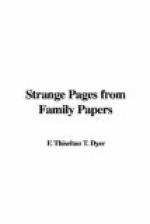There can be no doubt that there is many an old house in this country which, if thoroughly ransacked, would be found to contain treasures of the most valuable and costly kind. Some years ago, for example, a collection of pictures was discovered at Merton College, Oxford, hidden away between the ceiling and the roof; and missing deeds have from time to time been discovered located in all sorts of mysterious nooks. In a set of rooms in Magdalen College, too, which had been originally occupied by one of the Fellows, and had subsequently been abandoned and devoted to lumber, was unearthed a strong wooden box, containing, together with some valuable articles of silver plate, a beautiful loving-cup, with a cover of pure gold. When, also, the Vicarage house of Ormesby, in Yorkshire, required reparation, some stonework had to be removed in order to carry out the necessary alterations, in the course of which a small box was found, measuring about a foot square, which had been embedded in the wall. The box, when opened, was full of angels, angelets, and nobles. Some of the money was of the reign of Edward IV., some of Henry VI., and some, too, of the reigns of Henry VII. and Henry VIII. It has been suggested that when Henry VIII. dissolved the lesser monasteries, the monks of Guisboro’ Priory, which was only about six miles off, fearing the worst, fled with their treasures, and, with the craft and cunning peculiar to their order, buried a portion of them in the walls of the parsonage house of Ormesby.[52]
To quote another case, Dunsford, in his “Memories of Tiverton” (1790), p. 285, speaking of the village of Chettiscombe, says that in the middle of the 16th century, in the north part of this village was “a chapel entire, dedicated to St. Mary. The walls and roof are still whole, and served some years past for a dwelling-house, but is now uninhabited.” It appears that not only was there some superstition attaching to this building, which accounted for its untenanted condition, but certain money was supposed to be hidden away, to discover which every attempt had hitherto been in vain. “It was therefore proposed,” says the author, “that some person should lodge in the chapel for a night to obtain preternatural information respecting it. Two persons at length complied with the request to do so, and, aided by strong beer, approached about nine o’clock the hallowed walls. They trembled exceedingly at the sudden appearance of a white owl that flew from a broken window with the message that considerable wealth lay in certain fields, that if they would diligently dig there, they would undoubtedly find it.” They quickly attended to this piece of information, and employed a body of workmen who, before long, succeeded in bringing to light the missing money.




